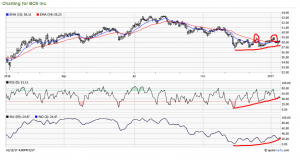A reverse call ratio spread (call backspread) on BCE Inc. (BCE)

As you can see in the following graph, shares in BCE Inc. (BCE) have been trading in a range of $57 to $59 since mid-November, with points of momentum suggesting a slightly bullish trend.
Daily Graph of BCE ($58.19 on Friday, January 13, 2017)

We can also see that the stochastic oscillator (the lower indicator) has begun to trend upward, while the RSI indicator (above) is on a bullish trend. If BCE maintains this upward momentum, it may approach $63 by May 2017.
To make the most of this scenario, we will implement a strategy designed to turn a profit if BCE closes at a price of $63 or better upon expiration on May 19, 2017. However, since nothing is guaranteed and the price of BCE could fall, the selected strategy will also allow us to benefit if the price drops to below $56, should this occur.
Reverse Call Ratio Spread
The strategy is called a reverse call ratio spread (or a call backspread). It consists of writing a call option with a strike of X and buying two or more calls with a strike of Y, where Y is greater than X.
Position
- Sell 10 call options, BCE 170319 C 56, at $2.60
- Credit of $2,600
- Buy 20 put options, BCE 170319 C 59, at $1.08
- Debit of $2,160
- Total credit of $440
Profit and Loss Profile
As you can see in the above graph, we are well positioned to profit if the price of BCE rises above the higher breakeven price of $61.56 or if it drops below the lower breakeven price of $56.44, with a maximum profit of $440 below the $56 strike.
However, we will incur a loss if the price of BCE stays between these two breakeven prices. This loss could be as much as $2,560 if BCE closes exactly at the $59 strike price upon expiration on May 19, 2017.
Consequently, since we do not want to risk incurring the maximum loss, we will close the position in two months if BCE is still trading somewhere between the two breakeven prices.
We are also considering locking in a profit if BCE reaches a price of $63 or more.
Good luck with your trading, and have a good week!
The strategies presented in this blog are for information and training purposes only, and should not be interpreted as recommendations to buy or sell any security. As always, you should ensure that you are comfortable with the proposed scenarios and ready to assume all the risks before implementing an option strategy.
President
Monetis Financial Corporation
Martin Noël earned an MBA in Financial Services from UQÀM in 2003. That same year, he was awarded the Fellow of the Institute of Canadian Bankers and a Silver Medal for his remarkable efforts in the Professional Banking Program. Martin began his career in the derivatives field in 1983 as an options market maker for options, on the floor at the Montréal Exchange and for various brokerage firms. He later worked as an options specialist and then went on to become an independent trader. In 1996, Mr. Noël joined the Montréal Exchange as the options market manager, a role that saw him contributing to the development of the Canadian options market. In 2001, he helped found the Montréal Exchange’s Derivatives Institute, where he acted as an educational advisor. Since 2005, Martin has been an instructor at UQÀM, teaching a graduate course on derivatives. Since May 2009, he has dedicated himself full-time to his position as the president of CORPORATION FINANCIÈRE MONÉTIS, a professional trading and financial communications firm. Martin regularly assists with issues related to options at the Montréal Exchange.
The information provided on this website, including financial and economic data, quotes and any analysis or interpretation thereof, is provided solely for information purposes and shall not be construed in any jurisdiction as providing any advice or recommendation with respect to the purchase or sale of any derivative instrument, underlying security or any other financial instrument or as providing legal, accounting, tax, financial or investment advice. Bourse de Montréal Inc. recommends that you consult your own advisors in accordance with your needs before making decision to take into account your particular investment objectives, financial situation and individual needs.
All references on this website to specifications, rules and obligations concerning a product are subject to the rules, policies and procedures of Bourse de Montréal Inc. and its clearinghouse, the Canadian Derivatives Clearing Corporation, which prevail over the content of this website. Although care has been taken in the preparation of the documents published on this website, Bourse de Montréal Inc. and/or its affiliates do not guarantee the accuracy or completeness of the information published on this website and reserve the right to amend or review, at any time and without prior notice, the content of these documents. Neither Bourse de Montréal Inc. nor any of its affiliates, directors, officers, employees or agents shall be liable for any damages, losses or costs incurred as a result of any errors or omissions on this website or of the use of or reliance upon any information appearing on this website.
BAX®, CADC®, CGB®, CGF®, CGZ®, LGB®, MX®, OBX®, OGB®, OIS-MX®, ONX®, SCF®, SXA®, SXB®, SXF®, SXH®, SXM®, SXO®, SXY®, and USX® are registered trademarks of the Bourse. OBW™, OBY™, OBZ™, SXK™, SXJ™, SXU™, SXV™, Montréal Exchange and the Montréal Exchange logo are trademarks of the Bourse. All other trademarks used are the property of their respective owners.
© 2024 Bourse de Montréal Inc. All Rights Reserved.
